6 min to read
If you’re marketing an e-commerce brand and you’re not using Google Shopping then you are missing out big time!
What is Google Shopping?
Google Shopping Ads or Product Listing Ads (PLAs) allows e-commerce stores get their products in front of users that are actively searching for them. Searchers will be able to see the product’s photo, title, reviews and the price
: 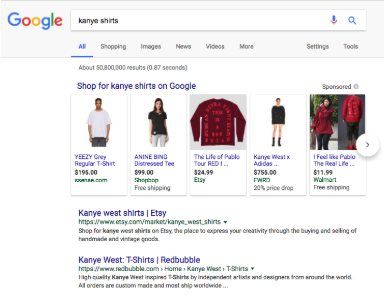
Google Shopping Result on Google Search - source
In fact, Shopping Ads convey much more context to the searcher than traditional text ads do. This results in more qualified traffic entering your site from these ads. PLAs can appear on Google Search, Google Shopping, Google Images and across some Google Search Partners like YouTube. A key difference between Google Search Ads and PLAs is that you don’t bid for keywords. In Shopping, Google determines which search queries trigger your ads according to a product feed.Even though Google “isn’t evil”, don’t let them control your campaigns.Do the following 5 steps before implementing your product feed to help you take ownership and run a profitable Google Shopping campaign.
Why is Google Shopping Relevant for Your E-Commerce Brand?
Before we dive in, these key statistics will compel you to invest in this marketing channel that is not (yet) saturated.While traditional text ads are undoubtedly the dominant force in most verticals, the scenario is different for retailers. As of Q1 2018, Google Shopping ads drove 76.4% of ad spend when compared with text ads and were responsible for 85.3% of the paid search clicks in the US.
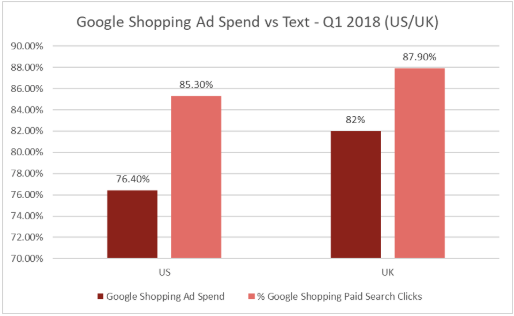
Adthena Search Advertising Report, 2018
Additionally, retailer’s ad spend on Google Shopping grew nearly one-third, whereas text ads ad spend grew only 1%. 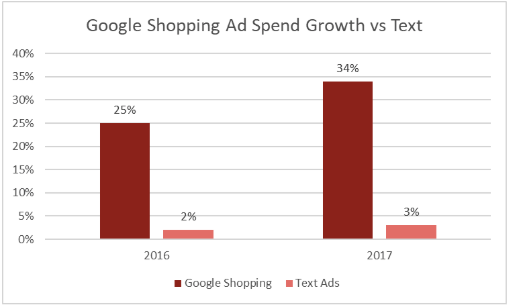
Google Shopping Benchmark Report, 2018
These figures confirm that retailers in both the US and UK are investing significantly more in Google Shopping than text ads, that PLAs offer a great ad spend/click ratio and that the market is growing fast.
How can you take advantage of it?
1) Devise Your Strategy for Google Shopping
Prerequisites to run PLAs
Comply with these main requirements:
-
The country where you sell must
support the language and currency of your product feed, which also should match the content on your landing pages, - Have a website with secure checkout (https),
- Images with a clean background, without promotional text or watermarks
Analyse what your competition is doing on Google Shopping
Head to Google Shopping and type in your most relevant products. Analyse your competitors postings and figure out what could differentiate you from the results, also write down their positive points and patterns.If you’re serious about competitive intelligence, use the Product Listing Ads Research on SEMrush’s paid plan to uncover their Google Shopping tactics over time, their search terms and what their ads look like.
Choose a target country, a budget and a goal
Afterwards, choose a country where you want to test your Shopping Ads, define a budget and set a smart goal.Due to the complexity in setting up a Shopping campaign, is recommended that you choose a subset of your e-commerce store to start.

2) Set up your Google Merchant Center account and link it to Google Ads
Moving on, you need to set up a Google Merchant Center account. This a different platform from Google Ads where you manage your product feeds 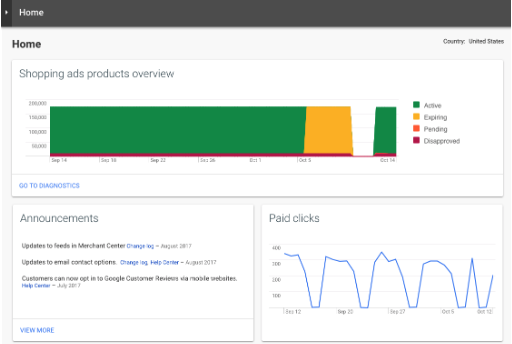
Google Merchant Center Dashboard
First, you’ll need to enter business information; your website, physical address, and detail your tax and shipping settings.Then, you must claim and verify the website’s URL. There are several ways you can do this; 1) by providing your Google Tag Manager container ID, 2) with Google Analytics, 3) with an HTML tag, or 4) through an HTML file upload.Lastly, you’ll need to connect your Merchant Center with Google Ads - the place where Shopping campaigns are managed.
3) Create your Google Shopping Product Feed
There are two main ways to build your product feed:
- Manually, with a Google Spreadsheet.
-
By using a paid service like
Data Feed Watch that retrieves data from your site and formats it according to Google’s specifications.
This decision will depend mostly on the number of products you have and your inventory turnover.
If you have a relatively small inventory and a medium-low inventory turnover, using a Google Spreadsheet is the best alternative. 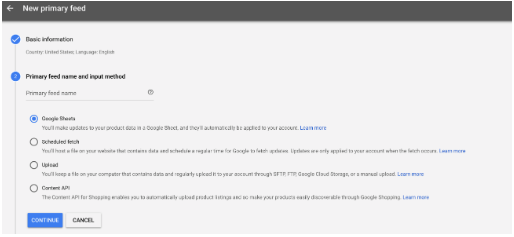
Creating a product feed using Google Sheets
Afterwards, choose an upload schedule considering your inventory turnover. If you need a daily update because you have products that quickly runs out of stock then set the fetch frequency accordingly.
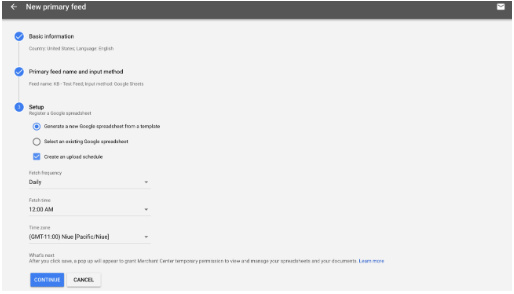
Setting the fetch frequency
4) Optimise your Google Shopping Product Feed
Since Google relies on your product feed to trigger your ads, optimisation is critical.Moreover, because it can be a daunting task, your competitors might have been too lazy to properly do it so you can get your leg up on the competition.
Craft the perfect Product Titles for your Product Feed
Optimising your product titles is the low-hanging fruit when improving the quality of your product feed.The common approach is to use a formula like , which may not suit you.To craft the perfect titles for your products, consider:
How your target consumer searches for the products you sell
If you sell electronics, people may be searching for a specific model. Therefore, you should include the model number on the product title.On the other hand, seldom do people search for product numbers when buying clothes. In this instance, other attributes like size, brand, gender or color are more relevant.Don’t rely on gut-feeling to choose your titles. Retrieve data from Google Search campaigns to discover patterns on the search queries of your bestsellers. Also, make a few searches on Google Shopping for those top items and analyse your competition.You can also use the Keyword Planner to find out what are users typing in to buy those products.
Google assigns more relevance to words in the beginning
Even though Google will only show the first 70 characters on the ad, the limit is 150 and you should use as much as you can - it’s free!Be as specific as you possibly can and order the words by its relevance.
What not to do in product titles
Do not repeat keywords. Do not add promotional text such as “50% Off”. Google allows you to showcase special promotions either by using the promotions tool in Merchant Center or by creating a promotion feed.
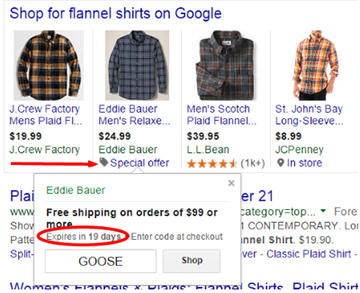
Google Shopping title optimisation - source
On these results, you can observe several approaches. Both J. Crew Factory and Eddie Bauer put their brands first, whereas L.L. Bean writes a super specific title combined with 1k+ reviews and throws the brand to the end.This illustrates the need to come up with a personalized approach when writing your titles and optimise your feed in a way that will make you stand out even if your brand is not the biggest.
Other optimisations to the Google Shopping Product Feed
Write your descriptions using the same rationale described above for titles.Choose the most granular Google Product Category and fill in optional attributes that make sense for your online store, such as the brand, gender, color or material.
5) Create a Google Shopping campaign structure that suits your needs
The appropriate structure gives you control over your budget allocation, where your ads appear and makes campaign management easier.
You can think about your campaign structure using this framework:
|
|
Bid | Priority |
| Pre-beta campaign | Low | High |
| Beta campaign | Medium | Medium |
| Alpha campaign | High | Low |
Supposing you sell shirts:
- Set up a pre-beta campaign with all the shirts in your feed.
- Have a beta campaign with several ad groups, often separated by brand or product categories. For instance, if you preferred to partition by categories, you would end up with t-shirts, sweatshirts and so on.
- Create an alpha campaign with the most profitable shirts you sell, separated at the most granular level possible such as the SKU.
So, if alpha is the most important campaign, why do we assign a low priority?
Priority is a setting that only exists in Google Shopping where the highest priority campaign will win the auction unless it runs out of budget.
However, by using negative keyword lists we direct the traffic to the appropriate campaigns.
For example, you set up a negative list with the alpha shirts and apply it to the beta and pre-beta campaigns.
This forces Google to show your PLAs to the search queries that match your products, even if they have lower bids on the pre-beta campaigns, while focusing your attention on managing only your top products at the SKU level.
Final Thoughts
The fashion online retailer Farfetch used Shopping Ads to expand to four countries and saw decrease in its cost per acquisition (CPA) by 20%.
if you have any questions about your Digital Marketing Strategy then send us an email!
About the Expert

This week's Voice of Experts was written by Francisco Sá Marques, PPC Expert at Codedesign. When he isn't building traffic systems, he's probably playing Red Hot Chili Peppers on his guitar.



Add comment ×